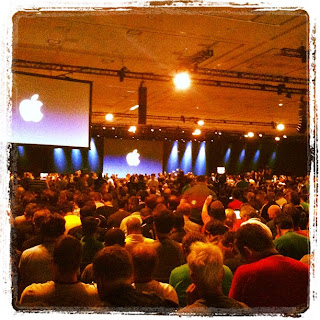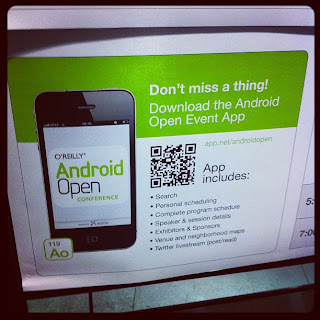The Pilgrimage:
I'd heard of this event that happened each year at WWDC where a group of attendees would travel with bus loads of other attendees and visit the corporate Apple store and buy some swag, take pictures, hang out and eat a bit of lunch on the Sunday before the main event.
The registration for WWDC opened promptly at 9am on Sunday morning. I had no idea what to expect as I walked from my hotel to the Moscone West building. But as I approached the number of nerdy looking folks seemed to certainly swell. There must have been a few hundred other developers keen to pick up their badges and whatever swag Apple was providing attendees. As the doors opened everyone was sucked into the building and a lot of people just started taking pictures. I couldn't help it. I did too.
After collecting my badge and swag I had some time to kill so I had some Starbucks and browsed the inter-tubes until it was time to meet for the Pilgrimage to Cupertino. Once on the bus I met a nice fellow from Eastern Europe. It felt strange to me explaining to fellow WWDC attendees that I don't actually do iOS or OSX development full time. In fact I do very little. But I explained that I was trying to change that and hoped that my attendance would help me to bring that change into being.
Actually being at the Apple offices wasn't all that interesting. It was basically an office building in a sea of other office buildings. We got to mull around the parking lot and buy some more Apple branded swag in the corporate gift shopt. I had lunch with some more nice people at the local restaurant that apparently a lot of Apple employees frequent.
The experience was good, but not something I'd likely repeat. Unless I attended with some other co-workers or friends again in the future. I'm a bit shy, so going on my own is a bit of a lonely road to take.
Actually being at the Apple offices wasn't all that interesting. It was basically an office building in a sea of other office buildings. We got to mull around the parking lot and buy some more Apple branded swag in the corporate gift shopt. I had lunch with some more nice people at the local restaurant that apparently a lot of Apple employees frequent.
The experience was good, but not something I'd likely repeat. Unless I attended with some other co-workers or friends again in the future. I'm a bit shy, so going on my own is a bit of a lonely road to take.
Keynote Day:
I'd heard of the ridiculousness of the Keynote day and read all about how some people start to line up in the wee-hours of the morning to ensure a relatively close seat. I was not one of these people. This too is something I would never do on my own. But with a couple others and some planning, I could be convinced to give it a shot.
My experience was however pretty interesting. I managed to end up in line not far from the front door to the center. Except that my position was after the line had wrapped itself 3/4 of the way around the block. So my hopes of getting in the main room were pretty slim. As luck would have it, I was in line very near a rather interesting and talkative fellow. His name was Bill Atkinson. Most people probably don't recognize that name. But he wasn't shy about telling his tails. Bill was a very, very early employee of Apple. I believe he said he was number 30. He hand some great stories about shipping the first Lisa and Mac. Although the stories have blurred together for me and are starting to fade. I was definitely a bit star struck. Especially when he started to talk about the fact that he and Steve Jobs actually still met and talked not too long prior to his passing. I also found it interesting that this man, with his lineage was still forced to wait in line with the rest of us. It made me a bit doubtful of the stories. So once I had a viable internet connection I made sure to look him up. Sure enough - this was the real deal. Now I wished I'd got an autograph. Although I'm not sure what I would have got him to sign.

After what seemed like an eternity of waiting and milling about in the lumbering and slowly moving line I finally got into the main ballroom where the keynote would be held. I found a seat and waited patiently for it to happen. And it was fantastic. Just watch the video.
My experience was however pretty interesting. I managed to end up in line not far from the front door to the center. Except that my position was after the line had wrapped itself 3/4 of the way around the block. So my hopes of getting in the main room were pretty slim. As luck would have it, I was in line very near a rather interesting and talkative fellow. His name was Bill Atkinson. Most people probably don't recognize that name. But he wasn't shy about telling his tails. Bill was a very, very early employee of Apple. I believe he said he was number 30. He hand some great stories about shipping the first Lisa and Mac. Although the stories have blurred together for me and are starting to fade. I was definitely a bit star struck. Especially when he started to talk about the fact that he and Steve Jobs actually still met and talked not too long prior to his passing. I also found it interesting that this man, with his lineage was still forced to wait in line with the rest of us. It made me a bit doubtful of the stories. So once I had a viable internet connection I made sure to look him up. Sure enough - this was the real deal. Now I wished I'd got an autograph. Although I'm not sure what I would have got him to sign.

After what seemed like an eternity of waiting and milling about in the lumbering and slowly moving line I finally got into the main ballroom where the keynote would be held. I found a seat and waited patiently for it to happen. And it was fantastic. Just watch the video.
Sessions, Sessions, Sessions:
My next few days were wall-to-wall sessions that I'm still not really allowed to talk about. I went to sessions that covered a lot of the topics discussed in the keynote. But I mostly stayed away from the social stuff. Not really my cup of tea. Although, not being an iOS or OSX developer proper, nothing really is my cup I suppose. I just attended the sessions that covered topics I found interesting. In particular, topics related to the developer tools, new language features and compelling new APIs that would soon be available. I'd also have to fight to get decent internet connectivity the entire week. I'd heard that the wireless was really good at WWDC, but this year must have been an exception.
Hump Day:
 Typically, I got back to the hotel at the end of a day of sessions and decompress for a while. Then either grab some dinner or actually go to bed early so I could be up early for the next day. This is the genesis of my very recent obsession with podcasts. I started to listen to Marco Arment and John Gruber's podcasts in these afternoons. Given the heavy Apple bent in the topics covered, they felt very much at home and they even had a couple that came out while the conference was still going on. I also followed the adventures of a number of the various popular Mac and iOS developers who were in attendance. I follow some folks form Martian Craft, Panic, Pacific Helm, Black Pixel and others. The sessions also gave me some incite into those folks on twitter who were from Apple. There are a lot more of them than I'd realized and they are pretty active posters on the social network. Notably though they seem to be developer facing employees that we are supposed to be able to reach. So it's not really all that surprising. But I'd not been able to locate them previously, so I was still quite pleased and surprised.
Typically, I got back to the hotel at the end of a day of sessions and decompress for a while. Then either grab some dinner or actually go to bed early so I could be up early for the next day. This is the genesis of my very recent obsession with podcasts. I started to listen to Marco Arment and John Gruber's podcasts in these afternoons. Given the heavy Apple bent in the topics covered, they felt very much at home and they even had a couple that came out while the conference was still going on. I also followed the adventures of a number of the various popular Mac and iOS developers who were in attendance. I follow some folks form Martian Craft, Panic, Pacific Helm, Black Pixel and others. The sessions also gave me some incite into those folks on twitter who were from Apple. There are a lot more of them than I'd realized and they are pretty active posters on the social network. Notably though they seem to be developer facing employees that we are supposed to be able to reach. So it's not really all that surprising. But I'd not been able to locate them previously, so I was still quite pleased and surprised. Sensory Overload:
The last couple days were a bit of a grind. I bowed out of the beer bash due to my exhaustion. I'm still not sure if I regret that decision or not. I made a plan to visit some family that lived in the area on Friday after the conference wrapped up. That helped. But I was mostly missing my own family. I had a few FaceTime chats where my daughter would be kissing my face on my iPad at home and I'd see the top of her head as she did. It was pretty cute, but I also really wanted to be home after those calls.
Wrapped Up:
The last day there was a really well done lunch time talk by J.J. Abrams. He plugged his iOS app a bit, but really gave the crowed a great review of his progress from a nobody to the Hollywood darling he is today. That afternoon I took a train to see my family got to play with my 2nd cousin for a while. It was oddly peaceful to be around a toddler again.
I still think about the week and all the things I didn't do and wish I had. I hope to get to go back again another year with some friends and co-workers to better take advantage of all the week has to offer. I'd also like to come back with some code and an application I'm working on so that I can have something to talk with the Apple engineers in attendance. I felt like I really didn't get to make use of the value of such a resource being so close this time around.
I really liked my first dub-dub. I hope it's not my last.
I still think about the week and all the things I didn't do and wish I had. I hope to get to go back again another year with some friends and co-workers to better take advantage of all the week has to offer. I'd also like to come back with some code and an application I'm working on so that I can have something to talk with the Apple engineers in attendance. I felt like I really didn't get to make use of the value of such a resource being so close this time around.
I really liked my first dub-dub. I hope it's not my last.










